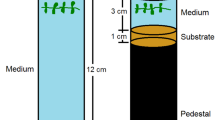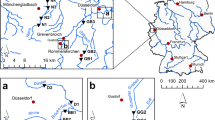Abstract
Many invasive macrophytes reproduce through fragments that are transported actively or passively to new habitats. On arrival, regeneration of fragments and colonisation of the new environment are critical steps in the invasion process. The effects of environmental and plant factors that potentially affect regeneration and colonisation success of Cabomba caroliniana A. Gray (Cabombaceae; cabomba, fanwort) were studied. C. caroliniana fragments had a very high regeneration potential that was not affected by nutrient availability. However, larger and apical fragments had higher establishment rate and regenerative growth. The coarseness of the substrate did not have any effect on establishment of C. caroliniana. Overall, even a single-node fragment had 50% establishment success when planted in substrate and this increased to 100% for fragments with two or more nodes. In contrast, free-floating propagules had only a 1–30% chance of colonisation, depending on the size of the fragment. It appears that propagule pressure is of less importance for the colonisation of C. caroliniana than the process of physical establishment in the substrate which acts as a bottleneck. Future work should address the specific processes that determine retention and establishment of propagules in the sediment.






Similar content being viewed by others
References
Akasaka, M. & N. Takamura, 2011. The relative importance of dispersal and the local environment for species richness in two aquatic plant growth forms. Oikos 120: 38–46.
Barko, J. W., D. Gunnison & S. R. Carpenter, 1991. Sediment interactions with submersed macrophyte growth and community dynamics. Aquatic Botany 41: 41–65.
Barnes, M. A., C. L. Jerde, D. Keller, W. L. Chadderton, J. G. Howeth & D. M. Lodge, 2013. Viability of aquatic plant fragments following desiccation. Invasive Plant Science and Management 6: 320–325.
Barrat-Segretain, M.-H., 1996. Strategies of reproduction, dispersion, and competition in river plants: a review. Vegetatio 123: 13–37.
Barrat-Segretain, M.-H. & G. Bornette, 2000. Regeneration and colonization abilities of aquatic plant fragments: effect of disturbance seasonality. Hydrobiologia 421: 31–39.
Barrat-Segretain, M.-H., G. Bornette & A. Hering-Vilas-Bôas, 1998. Comparative abilities of vegetative regeneration among aquatic plants growing in disturbed habitats. Aquatic Botany 60: 201–211.
Bickel, T. O., 2012. Ecology of the submersed aquatic weed Cabomba caroliniana in Australia. In Eldershaw, V. (ed.) Eighteenth Australasian Weeds Conference, Melbourne, 8–11 October 2012. Weed Society of Victoria: 21–24.
Bickel, T. O., 2015. A boat hitchhiker’s guide to survival: Cabomba caroliniana desiccation resistance and survival ability. Hydrobiologia 746: 123–134.
Bickel, T. O. & C. Perrett, 2016. Precise determination of aquatic plant wet mass using a salad spinner. Canadian Journal of Fisheries and Aquatic Sciences 73: 1–4.
Bruckerhoff, L., J. Havel & S. Knight, 2015. Survival of invasive aquatic plants after air exposure and implications for dispersal by recreational boats. Hydrobiologia 746: 113–121.
Colautti, R., I. Grigorovich & H. MacIsaac, 2006. Propagule pressure: a null model for biological invasions. Biological Invasions 8: 1023–1037.
Heidbüchel, P., K. Kuntz & A. Hussner, 2016. Alien aquatic plants do not have higher fragmentation rates than native species: a field study from the River Erft. Aquatic Sciences 78: 767–777.
Jacobs, M. J. & H. J. Macisaac, 2009. Modelling spread of the invasive macrophyte Cabomba caroliniana. Freshwater Biology 54: 296–305.
Johnson, L. E., A. Ricciardi & J. T. Carlton, 2001. Overland dispersal of aquatic invasive species: a risk assessment of transient recreational boating. Ecological Applications 11: 1789–1799.
Johnstone, I. M., B. T. Coffey & C. Howard-Williams, 1985. The role of recreational boat traffic in interlake dispersal of macrophytes: a New Zealand case study. Journal of Environmental Management 20: 263–279.
Kimbel, J. C., 1982. Factors influencing potential intralake colonization by Myriophyllum spicatum L. Aquatic Botany 14: 295–307.
Kuntz, K., P. Heidbüchel & A. Hussner, 2014. Effects of water nutrients on regeneration capacity of submerged aquatic plant fragments. Annales de Limnologie 50: 155–162.
Langeland, K. A. & D. L. Sutton, 1980. Regrowth of Hydrilla from axillary buds. Journal of Aquatic Plant Management 18: 27–29.
Mackey, A. P. & J. T. Swarbrick, 1997. The biology of Australian weeds 32. Cabomba caroliniana Gray. Plant Protection Quarterly 12: 154–165.
Madsen, T. V. & N. Cedergreen, 2002. Sources of nutrients to rooted submerged macrophytes growing in a nutrient-rich stream. Freshwater Biology 47: 283–291.
Madsen, J. D., L. W. Eichler & C. W. Boylen, 1988. Vegetative spread of Eurasian Watermilfoil in Lake George, New York. Journal of Aquatic Plant Management 26: 47–50.
McAlarnen, L. A., M. A. Barnes, C. L. Jerde & D. M. Lodge, 2012. Simulated overland transport of Eurasian watermilfoil: survival of desiccated plant fragments. Journal of Aquatic Plant Management 50: 147–149.
McCracken, A., J. D. Bainard, M. C. Miller & B. C. Husband, 2013. Pathways of introduction of the invasive aquatic plant Cabomba caroliniana. Ecology and Evolution 3: 1427–1439.
Mielecki, M. & E. Pieczynska, 2005. The influence of fragmentation on the growth of Elodea canadensis Michx. in different light conditions. Polish Journal of Ecology 53: 155–164.
Nichols, S. A., 1991. The interaction between biology and the management of aquatic macrophytes. Aquatic Botany 41: 225–252.
Ørgaard, M., 1991. The genus Cabomba (Cabombaceae) –a taxonomic study. Nordic Journal of Botany 11: 179–203.
Puth, L. M. & D. M. Post, 2005. Studying invasion: have we missed the boat? Ecology Letters 8: 715–721.
R Core Team, 2016. R: a Language and Environment for Statistical Computing. 3.3.0 edn. R Foundation for Statistical Computing, Vienna.
Redekop, P., D. Hofstra & A. Hussner, 2016. Elodea canadensis shows a higher dispersal capacity via fragmentation than Egeria densa and Lagarosiphon major. Aquatic Botany 130: 45–49.
Riis, T., 2008. Dispersal and colonisation of plants in lowland streams: success rates and bottlenecks. Hydrobiologia 596: 341–351.
Riis, T. & K. A. J. Sand-Jensen, 2006. Dispersal of plant fragments in small streams. Freshwater Biology 51: 274–286.
Riis, T., T. V. Madsen & R. S. H. Sennels, 2009. Regeneration, colonisation and growth rates of allofragments in four common stream plants. Aquatic Botany 90: 209–212.
Smart, R. M. & J. W. Barko, 1985. Laboratory culture of submersed freshwater macrophytes on natural sediments. Aquatic Botany 21: 251–263.
Spencer, W. & G. Bowes, 1990. Ecophysiology of the world’s most troublesome aquatic weeds. In Pieterse, A. H. & K. J. Murphy (eds), Aquatic Weeds: the Ecology and Management of Nuisance Aquatic Vegetation. Oxford University Press, Oxford: 39–73.
Umetsu, C. A., H. B. A. Evangelista & S. M. Thomaz, 2012a. Colonization, regeneration potential and growth rates of fragments of the exotic aquatic macrophyte Hydrilla verticillata. Aquatic Biology 16: 197–202.
Umetsu, C. A., H. B. A. Evangelista & S. M. Thomaz, 2012b. The colonization, regeneration, and growth rates of macrophytes from fragments: a comparison between exotic and native submerged aquatic species. Aquatic Ecology 46: 443–449.
van Valkenburg, J. L. C. H., R. M. M. Roijackers & R. Leonard, 2011. Cabomba caroliniana Gray in the Netherlands. In 3rd International Symposium on Weeds and Invasive Plants, Ascona, Switzerland, October 2011: 6.
Wilson, C. E., S. J. Darbyshire & R. Jones, 2007. The biology of invasive alien plants in Canada. 7. Cabomba caroliniana A. Gray. Canadian Journal of Plant Science 87: 615–638.
Wilson, J. R. U., E. E. Dormontt, P. J. Prentis, A. J. Lowe & D. M. Richardson, 2009. Something in the way you move: dispersal pathways affect invasion success. Trends in Ecology & Evolution 24: 136–144.
Acknowledgements
I thank Christine Perrett and Cameron Clarke for assisting with all the experimental works of the project. The research was funded by the Queensland Government, Queensland local Governments and through a Rural Industries Research Grant (RIRDC, PRJ-006986). The constructive comments of the reviewers and the editor helped to greatly improve the manuscript.
Author information
Authors and Affiliations
Corresponding author
Additional information
Handling editor: Luis Mauricio Bini
Electronic supplementary material
Below is the link to the electronic supplementary material.
10750_2016_2995_MOESM1_ESM.pdf
Mean precent regeneration of shoots from different fragment types over the course of the regeneration experiment. Supplementary Material 1 (PDF 10 kb)
10750_2016_2995_MOESM2_ESM.pdf
Mean precent regeneration of roots from different fragment types over the course of the regeneration experiment. Supplementary Material 2 (PDF 10 kb)
10750_2016_2995_MOESM3_ESM.pdf
Mean precent regeneration of shoots from different fragment types over the course of the nutrient regeneration experiment. Supplementary Material 3 (PDF 11 kb)
Rights and permissions
About this article
Cite this article
Bickel, T.O. Processes and factors that affect regeneration and establishment of the invasive aquatic plant Cabomba caroliniana . Hydrobiologia 788, 157–168 (2017). https://doi.org/10.1007/s10750-016-2995-0
Received:
Revised:
Accepted:
Published:
Issue Date:
DOI: https://doi.org/10.1007/s10750-016-2995-0




